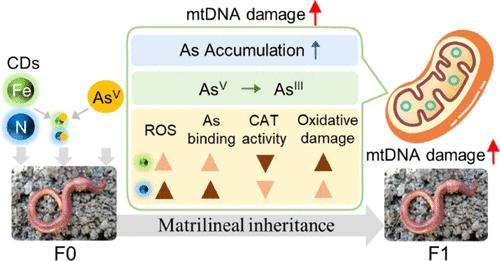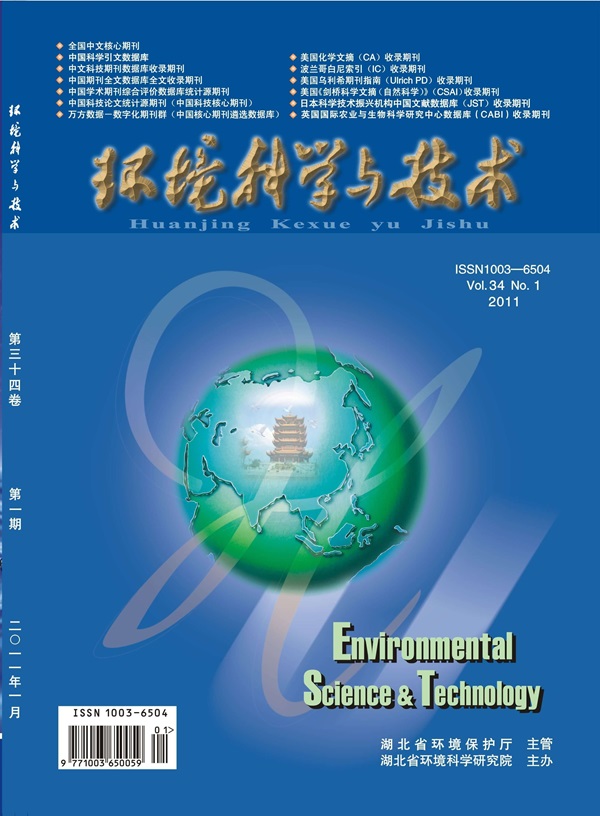碳点和砷酸盐对蚯蚓线粒体基因的跨代协同毒性:结合的关键作用
IF 10.8
1区 环境科学与生态学
Q1 ENGINEERING, ENVIRONMENTAL
引用次数: 0
摘要
碳点(CDs)在农业中的使用不断增加,引起了人们对生态问题的关注。然而,人们对其与砷的联合毒性仍然知之甚少。在此,我们研究了在环境相关浓度下,碳点和砷酸盐在蚯蚓连续世代中的线粒体遗传毒性。掺铁光盘(CDs-Fe)与砷酸盐和亚砷酸盐的结合力很强,而掺氮光盘(CDs-N)的结合力较弱。两种光盘都增强了砷酸盐的生物累积,但不影响其生物转化,大部分砷酸盐被还原成亚砷酸盐。CDs-Fe 产生的活性氧明显多于 CDs-N,对线粒体 DNA(mtDNA)造成了更严重的损伤。砷酸盐进一步加剧了 CDs-N 诱导的线粒体 DNA 氧化损伤,表现为活性氧增加、8-氧代-7,8-二氢-2′-脱氧鸟苷(8-OHdG)水平升高以及 8-OHdG 与线粒体 DNA 损伤之间的相关性升高。这是由于砷抑制了抗氧化酶过氧化氢酶。由于 CDs-Fe 与砷的强结合阻止了过氧化氢酶的抑制作用,因此 CDs-Fe 对这种损害的加剧可以忽略不计。母体线粒体 DNA 的损伤会遗传给子代蚯蚓,在共同暴露组中,子代蚯蚓的体重会显著下降,同时还伴有 mtDNA 的毒性。这项研究揭示了光盘和砷酸盐的协同遗传毒性,表明光盘可能会破坏砷的生物地球化学循环,增加陆生动物的砷酸盐风险,并通过多代影响来影响生态系统的稳定性和健康。本文章由计算机程序翻译,如有差异,请以英文原文为准。

Synergistic Mitochondrial Genotoxicity of Carbon Dots and Arsenate in Earthworms Eisenia fetida across Generations: The Critical Role of Binding
The escalating utilization of carbon dots (CDs) in agriculture raises ecological concerns. However, their combined toxicity with arsenic remains poorly understood. Herein, we investigated the combined mitochondrial genotoxicity of CDs and arsenate at environmentally relevant concentrations across successive earthworm generations. Iron-doped CDs (CDs–Fe) strongly bound to arsenate and arsenite, while nitrogen-doped CDs (CDs–N) exhibited weaker binding. Both CDs enhanced arsenate bioaccumulation without affecting its biotransformation, with most arsenate being reduced to arsenite. CDs–Fe generated significantly more reactive oxygen species than did CDs–N, causing stronger mitochondrial DNA (mtDNA) damage. Arsenate further exacerbated the oxidative mtDNA damage induced by CDs–N, as evidenced by increased reactive oxygen species, elevated 8-oxo-7,8-dihydro-2′-deoxyguanosine (8-OHdG) levels, and a higher correlation between 8-OHdG and mtDNA damage. This was due to arsenic inhibiting the antioxidant enzyme catalase. This exacerbation was negligible with CDs–Fe because their strong binding with arsenic prevented catalase inhibition. Maternal mitochondrial DNA damage was inherited by filial earthworms, which experienced significant weight loss in coexposure groups coupled with mtDNA toxicity. This study reveals the synergistic genotoxicity of CDs and arsenate, suggesting that CDs could disrupt the arsenic biogeochemical cycle, increase arsenate risk to terrestrial animals, and influence ecosystem stability and health through multigenerational impacts.
求助全文
通过发布文献求助,成功后即可免费获取论文全文。
去求助
来源期刊

环境科学与技术
环境科学-工程:环境
CiteScore
17.50
自引率
9.60%
发文量
12359
审稿时长
2.8 months
期刊介绍:
Environmental Science & Technology (ES&T) is a co-sponsored academic and technical magazine by the Hubei Provincial Environmental Protection Bureau and the Hubei Provincial Academy of Environmental Sciences.
Environmental Science & Technology (ES&T) holds the status of Chinese core journals, scientific papers source journals of China, Chinese Science Citation Database source journals, and Chinese Academic Journal Comprehensive Evaluation Database source journals. This publication focuses on the academic field of environmental protection, featuring articles related to environmental protection and technical advancements.
 求助内容:
求助内容: 应助结果提醒方式:
应助结果提醒方式:


